
Commercial
Creating the Workplace of the Future: the Rise of the Smart Office
Written by: Parcel Pending
5 Min Read
Published: November 30, 2023
Updated: May 24, 2024
Updated 05/22/2024
Among the fads of “quiet quitting,” “quiet firing,” and “lazy girl jobs,” there is a more pervasive and permanent trend: encouraging employees back into the office for at least two to three days per week. By embracing smart office technology and smart office solutions, employees can be enticed to return to an office that makes for a better employee experience.
A Tectonic Shift Towards Bringing Workers Back to the Office
When employees first fled from their offices during the pandemic, they left behind dedicated desks, disjointed technology tools, stationary filing cabinets, and often subpar ergonomic furniture. They appreciated skipping the commute, avoiding office chit-chat, and taking breaks as needed. Initially, the results were overwhelmingly positive, with employers believing they were boosting productivity while saving on rent. Some companies ditched their office space altogether. REI, for instance, sold its 400,000-square-foot headquarters in Washington for its 1600 employees before the company ever occupied the space!1
Now, however, the pendulum has shifted, with employers wanting employees in the office at least on a hybrid basis to increase productivity, collaboration, creativity, communication, and culture. New data suggests that working from home full-time may not be as productive as once thought. According to work-from-home expert and professor Jose Maria Barrero of ITAM in Mexico City, productivity slumps approximately 10% when employees work from home five days per week.2
Further, Gallup’s most recent poll also shows that the percentage of remote workers who said they felt a connection to the purpose of their organizations fell to 28% from 32% in 2022— the lowest level since before the pandemic.3
To lure employees back to the office on a more regular basis, companies must reimagine their office space as a superior place for working that seamlessly integrates with employees’ work-from-home days using the latest smart office products and innovative office technology.
Welcome to the New Smart Office
The days of foosball tables, free bagels, and coffee bars being enough to attract and retain employees are over. As David Barnett, Research Work Dynamics Director at JLL explains: “In today’s flight for quality, smart office technology is becoming more of an expectation than a luxury.”4 Workers are looking for smart offices with lightning-fast Internet, wow factors in smart meeting rooms, AI that anticipates their needs, and furniture that fosters communication. With hybrid work becoming the new reality, here are the top smart office technology necessities to incorporate into your smart workplace or office space:
#1 Mobile as the Center of the Universe
Similar to how hotels have supplanted room keys with digital technology on a smartphone or other mobile device, smart offices are also embracing the power of the phone. Elevator entry, office access control, covered parking access control, desk/smart meeting room booking, and even food orders are now in the palm of the employee’s hands, thanks to the power of mobile apps and other smart office solutions.
#2 Scheduling Software
Hot desking has taken center stage in smart workplace and office design. Simply put: hot desking is the term for non-dedicated workspaces; employees have a different desk or space each time they visit the office, triggering the need for a managed and transparent scheduling system. The latest improvement in smart workspaces is smart desk/smart meeting room booking software integrations with other communication tools such as Slack, Microsoft Teams, Google Meet, and even human resource systems to ensure employers know who is in the office when and employees know when their desk/meeting room reservations are confirmed.
#3 Electronic Visitor Logbooks
With the arrival of scheduling software also comes the need for smart office electronic visitor logs. Boasting modern touchscreens, this newer smart office solution allows for automatic identity confirmation, floor directory assistance, and real-time views as to who is in the office.
#4 Climate, Smart Lighting, & Air Controls
Leverage office technology to easily control lights, temperature, and air quality at your smart office. Connected thermostats – an easy-to-implement smart office solution – can sense how many people are in the room, the time of day, and the outside temperature to regulate the heat/cold – working as a solution to the battle of the thermostat. Monitoring air quality is also key. Metrikus highlights this point: “A recent study suggested that enhancing indoor air quality could be as effective in reducing aerosol transmission of viruses as vaccinating 50-60% of the population.”5,6
Smart Locker Technology: A Perk and a Safe Storage Solution
Without permanently assigned desks or cubicles, there’s a need for safely and securely transferring documents, badges, laptops, and other physical resources between employees in a hybrid work environment. Implementing an electronic locker solution such as Parcel Pending by Quadient’s Corporate Campus Hub™, for instance, allows employees to leverage smart commercial lockers to safely store and retrieve items within 10 seconds using a unique six-digit access code or by scanning a unique barcode from their mobile device. “Everyone wants to control their personal effects. With the open office colliding with the hybrid workplace, you don’t always know who is in the space. You want to know that your things are safely locked away,” explains Jeffrey Gay, an architect and designer for MOI.7
Now’s the time to implement smart office technology as a recruitment and retention tool, as well as to raise the bar of your company’s digital dexterity. Ready to lock in a smart parcel locker solution to your company’s package and asset management needs? Speak to one of our package management experts today.
Sources:
- Roberts, Paul & Long, Katherine Anne. REI to sell its never-used Bellevue headquarters and shift office work to multiple Seattle-area sites. www.seattletimes.com. August 12, 2020. https://www.seattletimes.com/business/local-business/rei-to-sell-its-new-bellevue-headquarters-and-shift-office-work-to-multiple-seattle-sites/
- Woods, Darian & Ma, Adrian. The evidence on remote work is changing. www.npr.org. August 4, 2023. https://www.npr.org/2023/08/04/1192246138/the-evidence-on-remote-work-is-changing
- Ellis, Lindsay. The Disconnect Between Remote Workers and Their Companies Is Getting Bigger. www.wsj.com. August 24, 2023. https://www.wsj.com/lifestyle/careers/the-growing-disconnect-between-remote-workers-and-their-companies-f7519676
- JLL. Why companies are flocking to the newest offices. www.us.jll.com. February 9, 2022. https://www.us.jll.com/en/trends-and-insights/workplace/why-companies-are-flocking-to-the-newest-offices
- Vernon, Emily. What does a smart office actually look like? Discover the key features and benefits. www.metrikus.io. January 11, 2021. https://www.metrikus.io/blog/what-does-a-smart-office-look-like
- Spena A, Palombi L, Corcione M, Carestia M, Spena VA. On the Optimal Indoor Air Conditions for SARS-CoV-2 Inactivation. An Enthalpy-Based Approach. Int J Environ Res Public Health. 2020 Aug 21;17(17):6083. doi: 10.3390/ijerph17176083. PMID: 32825607; PMCID: PMC7504028.
- Proctor, Carolyn M. Post-Covid offices are bringing in welcome design changes. www.bizjournals.com. July 16, 2021. https://www.bizjournals.com/washington/news/2021/07/16/post-covid-office-design-changes.html



